
Epiphytes growing on an oak branch: Cryphaea heteromalla and Orthotrichum affine. Image by D. Morris
1. Epiphytic Mosses
Since the onset of winter I have been out with my nose to trees and paths looking at the moss and liverwort flora of Whiteknights. This is the first in a series of blog posts describing some of the species I have found according to where they grow. I have not aimed to write an identification guide to our commonest species (e.g. Brachythecium rutabulum and Kindbergia praelonga), but to provide a glimpse of the fascinating biology and ecology of mosses and liverworts (bryophytes) as exampled by those occurring on campus. I have written this with the lay reader especially in mind, and so shall introduce any terminology and taxonomy as it becomes necessary. More information is available on Dr Jonathan Mitchley’s blog and in the BBS field guide. I hope that after reading these posts you will be curious enough to take a closer look at bryophytes, and if not learn how to name them at least to appreciate their varied beauty.
The bryo-flora of some habitats on campus, such as the grasslands, are poor owing to the dominance of vascular plants (flowering plants etc.) with which tiny bryophytes cannot compete. The four habitats covered in this blog, however, are inimical to the growth of most higher plants and are bryologically much more interesting. Bryophytes in such places are obvious to even the casual observer. The first two posts will cover bryophytes on trees, mosses first and then liverworts. I should particularly recommend bryophytes on trees as an area of focus for newcomers to bryology, for the species tend to stick to trees and be quite simple to identify after a little practice.

Hypnum cupressiforme: not a true epiphyte, growing as it does profusely on any bare surface on which it becomes established. Image by D. Morris
Many bryophytes are obligate epiphytes, i.e. grow only on trees. In the tropics whole families of flowering plants are adapted to growing epiphytically, but in the temperate zone the epiphytic life is one in which only bryophytes and lichens really succeed (also ferns in more oceanic regions). The best place to look for epiphytes on campus is around the clearing near the grotto in the southern part of the Wilderness.
Generally speaking the species of tree matters to its bryophyte flora, though most of the commoner epiphytes can be found on oak. Oak has a slightly acid bark, but the very acid bark of conifers will not host any proper epiphytes. The smooth acid bark of beech and hornbeam are also not usually very good for bryophytes. Some species I have found only on elder on campus, the corky basic bark of which soaks up water and can be festooned with moss. Near towns the high alkalinity of elder bark also acts as a strong buffer against pollution, to which epiphytic mosses, like lichens, are very sensitive. Elsewhere, ash trees and willow swamps are good for epiphytes, both of which trees have alkaline bark.
The classic and most abundant epiphytic moss is Orthotrichum affine, which forms green tufts or straggling mats to 2.5cm or so tall. This species belongs to the order Orthotrichales, consisting of one family of largely epiphytic species. There are three genera in the family, Orthotrichum, Ulota and Zygodon, all of which occur on campus. To identify a moss growing on a tree as an Orthotrichum usually all one need do is look for capsules amongst the leaves. The capsule is the spore-bearing vessel characteristic of bryophytes, and on Orthotrichum species even shrivelled old capsules persist for a long time and so may be found on all but very young plants. As will be seen in these posts, Whiteknights is remarkably rich in Orthotrichum species.

Left: Orthotrichum affine. Right: O. diaphinum. (a) Old capsules (note furrows on capsule and teeth at its mouth); (b) calyptra covering ripening capsule; (c) silvery tip to leaf. Image by Dr Jonathan Mitchley
The leafy parts of all but one Orthotrichum species look very similar. The exception is O. diaphinum which has an obvious silvery leaf tip. This species is especially common on elders on campus. To distinguish species generally one must look at the capsule, and also the calyptra and seta. The calyptra of a moss is a more or less hood-like protective covering to the capsule present while it develops. The seta of a moss is the stalk on which the capsule is borne; in most Orthotrichum species, e.g. O. affine, the seta is so short as to be invisible and so that the capsule is immersed amongst the leaves.
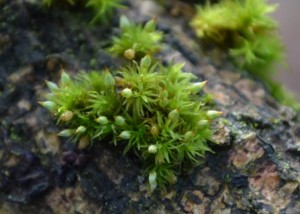
Orthotrichum pulchellum: the capsules are held very obviously clear of the leaves and the calyptra is dark-tipped with dark markings around the bottom edge. Image by D. Morris
An exception to the short seta rule is O. pulchellum, one of my favourite mosses. It occurs on a number of trees in the Wilderness, sometimes quite plentifully. Its specific name, pulchellum, means beautiful, an epithet with which I certainly agree. The seta in this species is long enough to hold the capsule clear of the leaves, and the calyptra is dark-tipped with dark markings around the base. The leafy shoots form neat short tufts. Although not common, O. pulchellum has become quite frequent with recent improvements in air quality.
I have also found a couple of specimens of O. tenellum, which is rare in these parts having a largely south-western distribution in the UK. The leafy shoots of this species are very short, 0.5cm or less, and the calyptra is obviously long and narrow, almost or completely covering the capsule. As the shoots are so short and the capsules so long, the habit of this plant is quite distinctive. Due to the relative rarity of this species I was in some uncertainty as to whether this might not be a small O. affine, but microscopic checking of the stomata on the capsule support my original suspicion. (Only the capsules of mosses have stomata; the leaves, being only one cell thick, have no need of them.)
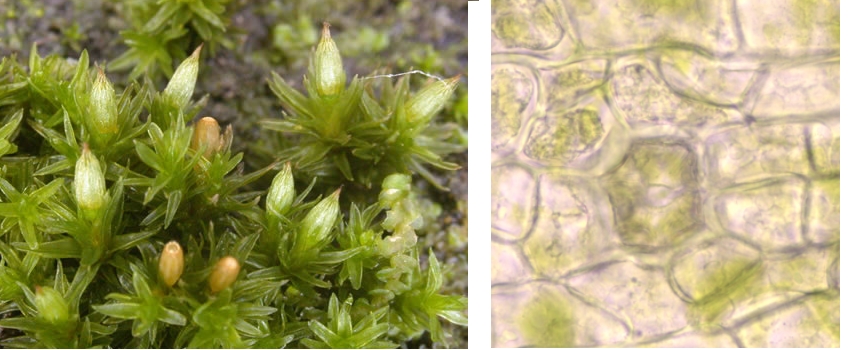
Left: Orthotrichum tenellum. Image by BBS. Right: Stoma of O. tenellum capsule (x400). Image by D. Morris. The stoma is clearly obscured by cells above it; in O. affine it would be round and superficial. It is really quite simple to cut open capsules and view stomata in this way – I recommend it to anyone interested in the genus.
There recently appeared in the magazine British Wildlife an excellent article by Sam Bosanquet on the identification of British and Irish Orthotrichum species, and which I recommend to anyone interested in this large and charming genus. Formerly scarce species (such as the two above) are becoming more and more frequent in the urbanised south east, so read the article and learn to identify possible new arrivals.
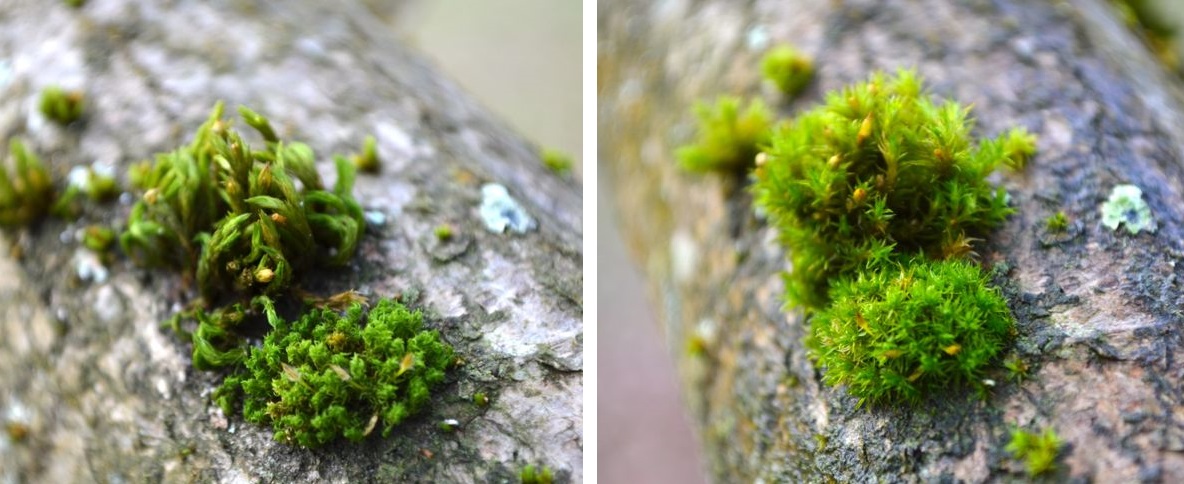
Growing on sharply draining substrates, epiphytes respond very quickly to changes in humidity. Left: Orthotrichum affine (top) and Ulota crispa (bottom) as found on a crisp winter afternoon. Right: the same plants immediately after being sprayed with water. Apart from size and capsules, one can tell the genera apart by the manner in which the leaves lie when dry. Image by D. Morris

Capsules of Ulota bruchii on long setae making the plant easy to spot amongst plentiful Orthotrichum affine. Image by D. Morris
The genus Ulota also deserves mention. The two commonest species are U. crispa and U. bruchii, both of which occur on campus, the latter more common than the former. It is only possible to tell these species apart when capsules are present during the winter/spring. Without capsules they could be mistaken for an Orthotrichum species, but when dry the leaves of a Ulota are crisped and curl round the stem, while in the latter the leaves are not crisped and lie flat against the stem as shown above.
These two Ulota species illustrate better than many Orthotrichum species the origin of the name Orthotrichum. For the calyptrae of Ulota have long more or less parallel hairs pointing straight from top to bottom (orthos = straight, trichos = hair). The capsules of Ulota species are long and narrow, tapering into the seta which holds the capsule further from the leaves than in any epiphytic Orthotrichum. In U. bruchii the capsule tapers to the mouth, while that of U. crispa is contracted below the mouth (definitely a job for the hand lens).

Cryphaea heteromalla: One can see clearly here all the capsules arising laterally on one side of the string-like secondary shoots. This plant is growing on an old elder. Image by D. Morris
Our final epiphytic moss is Cryphaea heteromalla. Unlike the above, this moss is branched and the capsules are borne not at the end of the shoots but laterally (i.e. it is a pleurocarp). The main shoots grow pressed against the tree, with secondary aerial branches sent straight upward. The almost unique feature of this moss is the way in which capsules are borne, being sessile and produced laterally in a row on just one side of the aerial branches. Cryphaea heteromalla will grow on many tree species but prefers hedgerows and the edges of woodland. It is easy to spot the loose patches of long aerial shoots resembling pieces of string reaching for the light.

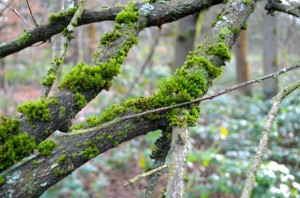
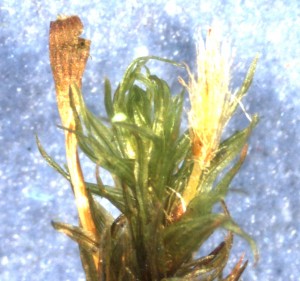
This is a great intro to epiphytes – thankyou. Have you still got the specimen of Orthotrichum tenellum from which the stomata were photographed, because it is far less obscured than is typical of O tenellum and looks much more typical of the much rarer O pallens and O schimperi. The macroscopic photo is credited to BBS, but there is no credit for the stoma so I’m hoping it’s your own!
Thank you, Sam, I am pleased you like it. It is my photograph and I do have the specimen. I only met O. tenellum for the first time recently, but I did think that the calyptra of the plant I found on campus was shorter than I’d seen elsewhere (i.e. didn’t completely cover the capsule) and the capsule tapered into the seta more than I thought Smith seemed to indicate O. tenellum should. You advise sending it off to the Orthotrichum referee do you?
It sounds very much like you have found O pallens, which would be an excellent addition to the recent series of finds of this species. Please send it to Tom Blockeel (address on http://www.britishbryologicalsociety.org.uk), and please let me know the result!
Marvellous! I sent it to him Friday and shall await his reply with great anticipation.